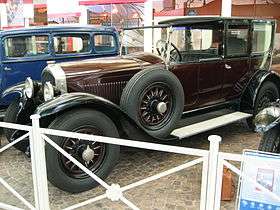Peugeot Type 176
| Peugeot Type 176 | |
|---|---|
 | |
| Overview | |
| Manufacturer | Peugeot SA |
| Production |
1925 - 1928 1512 produced[1] |
| Body and chassis | |
| Body style |
Limousine Sedanca de ville |
| Layout | FR layout |
| Powertrain | |
| Engine | 2493 cc straight-4 |
| Dimensions | |
| Wheelbase | 3,250 mm (128.0 in) |
| Length | 4,340 mm (170.9 in) |
| Width | 1,650 mm (65.0 in) |
| Chronology | |
| Predecessor | Peugeot Type 153 |
| Successor | Peugeot 601 |
The Peugeot Type 176 was a top of the range car produced from 1925 to 1928 by the French auto manufacturer Peugeot. The car had a four-cylinder 2493 cc engine, which was a more modern design than earlier, and despite the low cylinder capacity, the car performed better than its predecessors. With this engine the car could be pushed to a maximum speed of 110 kilometres per hour (68 mph). The car is featured in the film Midnight in Paris.
References
- ↑ "Peugeot Type 176". histomobile.com. Retrieved 2008-03-17.
| Peugeot, a marque of Groupe PSA, road vehicle timeline, 1889–1944 — next » | ||||||||||||||||||||||||||||||||||||||||||||||||||||||||
|---|---|---|---|---|---|---|---|---|---|---|---|---|---|---|---|---|---|---|---|---|---|---|---|---|---|---|---|---|---|---|---|---|---|---|---|---|---|---|---|---|---|---|---|---|---|---|---|---|---|---|---|---|---|---|---|---|
| Type | 1890s | 1900s | 1910s | 1920s | 1930s | 1940s | ||||||||||||||||||||||||||||||||||||||||||||||||||
| 9 | 0 | 1 | 2 | 3 | 4 | 5 | 6 | 7 | 8 | 9 | 0 | 1 | 2 | 3 | 4 | 5 | 6 | 7 | 8 | 9 | 0 | 1 | 2 | 3 | 4 | 5 | 6 | 7 | 8 | 9 | 0 | 1 | 2 | 3 | 4 | 5 | 6 | 7 | 8 | 9 | 0 | 1 | 2 | 3 | 4 | 5 | 6 | 7 | 8 | 9 | 0 | 1 | 2 | 3 | 4 | |
| Supermini | 1 | 2 | 3 / 4 | 5 / 6 / 7 / 8 | 21 / 24 / 30 / 31 | 37 | 54 | 57 | 69 "Bébé" | B P1/ B3/P1 "Bébé"¹ | 161/172 "Quadrilette" | 5CV | 190 | |||||||||||||||||||||||||||||||||||||||||||
| 26 / 27 / 28 | 48 | 56 | 58 | 126 | 201 | 202 | ||||||||||||||||||||||||||||||||||||||||||||||||||
| Small family car |
14 / 15 / 25 | 56 | 58 | 68 | VA/VC/VY¹ | V2C/V2Y¹ | VD/VD2¹ | 159 | 163 | 301 | 302 | |||||||||||||||||||||||||||||||||||||||||||||
| 33 / 36 | 63 | 99 | 108 | 118 | 125 | 173 / 177 / 181 / 183 | ||||||||||||||||||||||||||||||||||||||||||||||||||
| Family car |
9 / 10 / 11 / 12 | 16 / 17 / 19 / 32 | 49/50 | 65/67 | 77 | 78 | 88 | 127 | 143 | 153 | 153 B/BR | 176 | 401 | 402 | ||||||||||||||||||||||||||||||||||||||||||
| 18 | 39 | 43/44 | 61 | 71 | 81 | 96 | 106 | 116 | 126 | 138 | 175 | |||||||||||||||||||||||||||||||||||||||||||||
| Large family car |
23 | 42 | 62 | 72 | 82 | 92 | 104 | 112/117/ 122/130/134 | 139 | 145/146/148 | 174 | |||||||||||||||||||||||||||||||||||||||||||||
| 66 | 76 | 83 | 93 | 135 | 156 | 184 | ||||||||||||||||||||||||||||||||||||||||||||||||||
| Executive car |
80 | 103 | 113 | 141 | 147/150 | |||||||||||||||||||||||||||||||||||||||||||||||||||
| 85 | 95 | 105 | ||||||||||||||||||||||||||||||||||||||||||||||||||||||
| Cabriolet / Spider |
91 | 101/120 | 133 / 111/129/131 | 136 | 144 | |||||||||||||||||||||||||||||||||||||||||||||||||||
| Panel van | 13 | 22 | 34/35 | |||||||||||||||||||||||||||||||||||||||||||||||||||||
| Minibus | 20 / 29 | 107 | ||||||||||||||||||||||||||||||||||||||||||||||||||||||
| 1 These cars were marketed as "Lion-Peugeots", produced by what was till 1910 a separate Peugeot company, run by cousins of Armand Peugeot, then in charge of the principal automobile business.
In 1910, Armand having no sons of his own, it was agreed that the two branches of the Peugeot business be reunited. | ||||||||||||||||||||||||||||||||||||||||||||||||||||||||
This article is issued from Wikipedia - version of the 6/6/2016. The text is available under the Creative Commons Attribution/Share Alike but additional terms may apply for the media files.